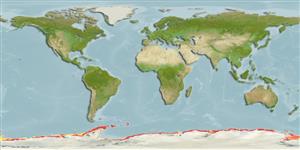Staurotheca densa Peña Cantero & Vervoort, 2003
| Native range | All suitable habitat | Point map | Year 2050 |

|
| This map was computer-generated and has not yet been reviewed. |
| Staurotheca densa AquaMaps Data sources: GBIF OBIS |
Upload your photos
Google image |
No photo available for this species.No drawings available for Sertulariidae.
Google image |
No photo available for this species.
Classification / Names Common names | Synonyms | CoL | ITIS | WoRMS
Hydrozoa | Leptothecata | Sertulariidae
Environment: milieu / climate zone / depth range / distribution range Ecology
Demersal; depth range 73 - 570 m (Ref. 7414). Polar
Distribution Countries | FAO areas | Ecosystems | Occurrences | Introductions
Circum-Antarctic.
Length at first maturity / Size / Weight / Age
Maturity: Lm ? range ? - ? cm Max length : 7.0 cm COLD male/unsexed; (Ref. 7414)
Short description Morphology
Colonies compact (up to 7 cm in diameter), mono- or polysiphonic, without distinct main stem. Branching subdichotomous and in one plane; branching pattern, however, hidden by presence of anastomoses, giving the colony an appearance of a dense net. Branches with perisarc constrictions, delimiting internodes of variable length and of approximately same diameter. Hydrothecae present along whole length of colony and arranged in decussate
verticils, typically with three to four hydrothecae per verticil, forming six to eight longitudinal rows. Verticils of hydrothecae closely packed; distal part of hydrothecae in a verticil sometimes overlapping basal part of hydrothecae in verticil above.
Shelf species. Recorded at depths 198 to 215 m and 73 to 570 m. Found on bottoms of pebbles (Ref. 7414).
Life cycle and mating behavior Maturity | Reproduction | Spawning | Eggs | Fecundity | Larvae
Members of the order Leptothecata include L-form hydroids. Life cycle: The zygote develops into planula and later into polyp then into free-swimming medusa.
Main reference
References | Coordinator | Collaborators
Peña Cantero, A.L. and W. Vervoort. 2003. (Ref. 7414)
IUCN Red List Status (Ref. 130435)
CITES status (Ref. 108899)
Not Evaluated
CMS (Ref. 116361)
Not Evaluated
Threat to humans
Harmless
Human uses
| FishSource |
Tools
More information
Internet sources
BHL | BOLD Systems | CISTI | DiscoverLife | FAO(Publication : search) | Fishipedia | GenBank (genome, nucleotide) | GloBI | Gomexsi | Google Books | Google Scholar | Google | PubMed | Tree of Life | Wikipedia (Go, Search) | Zoological Record
Estimates based on models
Preferred temperature
(Ref. 115969): -1.8 - 0.8, mean -0.8 (based on 293 cells).


